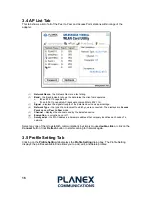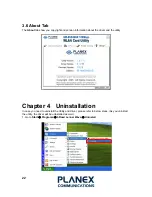
3.5.1.3 Wireless Security Setting
(1)
Authentication Mode
– the choices are Off, Open System, Shared Key, and WPA-PSK.
¾
Off
: No data encryption used.
¾
Open System
: Using Open System authentication, any wireless station can request
authentication. The station that needs to authenticate with another wireless station sends
an authentication management frame that contains the identity of the sending station. The
receiving station or AP grants any request for authentication. Open authentication allows
any device network access. If no encryption is enabled on the network, any device that
knows the SSID of the access point can gain access to the network.
¾
Shared Key
: Using Shared Key authentication, each wireless station is assumed to have
received a secret shared key over a secure channel that is independent from the 802.11
wireless network communications channel. Shared key authentication requires that the
client configure a static WEP key. The client access is granted only if it passed a challenge
based authentication.
¾
WPA-PSK
: Personal provides this level of security in the small network or home
environment. It uses a password also called a pre-shared key (PSK). The longer this
password the stronger the security of the wireless network. If your Wireless Access Point
or Router supports WPA Personal (WPA-PSK) then you should enable it on the access
point and provide a long, strong password. The same password entered into access point
needs to be used on this computer and all other wireless devices that access the wireless
network.
Please press
Next
for next step.
19
Summary of Contents for GW-DS54SGX
Page 1: ...2 4 GHz IEEE 802 11g 108Mbps Wireless LAN PCI Adapter GW DS54SGX ...
Page 7: ...7 6 Click Continue Anyway to continue 7 Click Finish to complete the installation ...
Page 10: ...2 Click Continue Anyway 10 3 Click Finish to complete the installation ...
Page 23: ...2 Select Remove and click Next 23 3 Click Finish to complete the uninstalled procedure ...







































